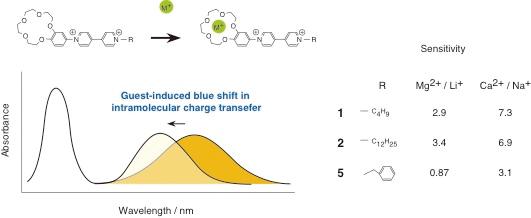Abstract
Two benzocrown ether–bipyridinium conjugates, 1 and 2, each having a different length of alkyl chains with butyl and dodecyl groups, respectively, have been synthesized for the purpose of developing a new guest-responsive color-change chemosensor. Both 1 and 2 showed yellow colors with broad absorption bands around 400 nm in acetonitrile. These are associated with the intramolecular charge transfer (CT) absorption, in which the benzocrown ether and bipyridinium units act as the donor and acceptor, respectively. Upon addition of the guest; such as Na+, they faded in color due to the blue shift in their intramolecular charge transfer absorption bands. These are associated with the formation of 1:1 host–guest inclusion complex. Analogues, 3 and 4, both being similar in structure to 1 and 2 with non-crown ether unit, also showed intramolecular CT absorptions around 400 nm, but did not change their absorption spectra upon addition of the guest because of the lack of guest-binding abilities. The guest-induced color change of 1 and 2 can be used for alkali and alkaline metal ion sensing. Both 1 and 2 could detect divalent cations such as Mg2+ and Ca2+ rather than univalent ones, Li+, Na+, K+, Rb+, and Cs+. Although a marked difference between 1 and 2 was not observed in their guest sensing abilities, the remarkable recognition of 1 and 2 for Mg2+ and Ca2+ was found compared with that of 5, which has benzyl unit instead of alkyl chains of 1 and 2. The sensitivity values of 1 and 2 were roughly proportional to their binding constants, as shown by the binding constants with Li+, Na+, Mg2+, and Ca2+ with the values of 910, 260, 820, and 2300 M−1 for 1 and 930, 290, 1270, and 2790 M−1 for 2, while the binding constants of 5 were estimated to be 930, 440, 210, and 1200 M−1 for Li+, Na+, Mg2+, and Ca2+, respectively. The limit concentration of detection of 2 for Ca2+ was estimated to be 0.016 mM, which was the smallest value in this system.



